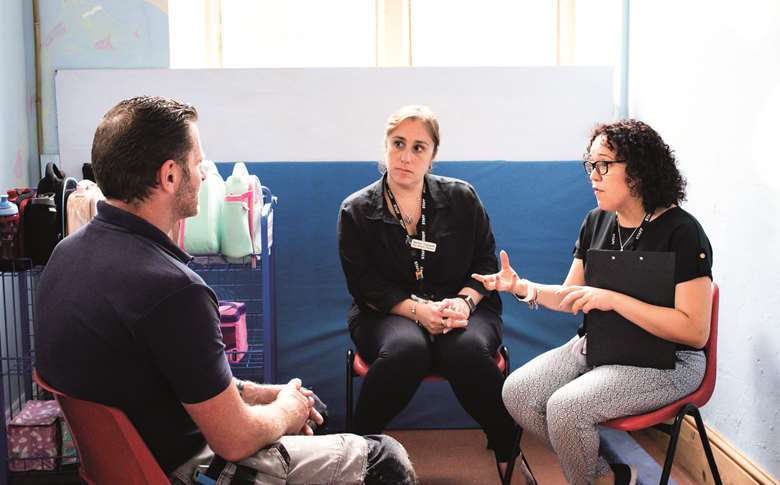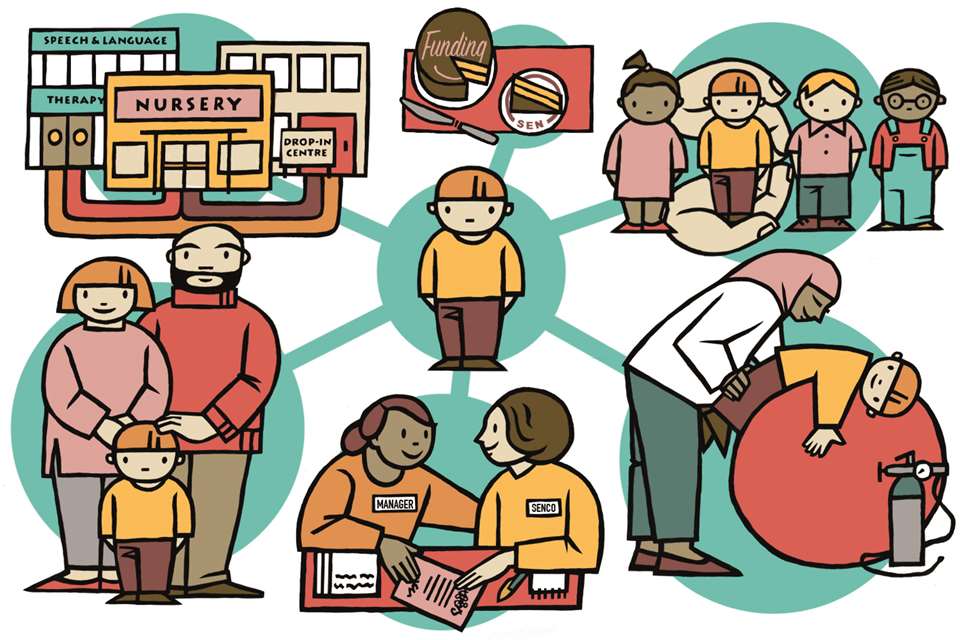Inclusion: Hard to say
Gabriella Jozwiak
Wednesday, September 1, 2021
Having conversations with parents about their child’s newly identified additional needs can be difficult. Gabriella Jozwiak looks at best practice and responsibilities for settings

When delivering a course for practitioners on meeting the needs of children with special educational needs or disability (SEND), National Association for Special Educational Needs education officer (early years) Mandy Wilding includes a poem called Welcome to Holland by Emily Perl Kingsley.
‘When you’re going to have a baby, it’s like you’re planning a vacation to Italy. You’re all excited,’ it begins. ‘Only when you land …there’s been a change of plan …you’ve landed in Holland and there you must stay.’
Reciting poetry is not always appropriate when informing a parent their child has an additional need. But Ms Wilding uses the poem to help practitioners understand how a parent may feel when they discover their child is different from what they believed. ‘It’s an adjustment process,’ says Ms Wilding. ‘We stress empathy rather than sympathy. You’ve got to put yourself in their shoes.’
FIRST TO KNOW
Early years practitioners are often the first to identify additional needs. When this happens, every setting should already have SEND protocol in place. This should detail what information practitioners should record about each child, how to carry out observations of children in the setting, and information on how and when to express concerns.
‘It should all be clearly laid out so everybody knows what they’re doing,’ says Ms Wilding. If concerns arise, she recommends practitioners follow the graduated approach with four stages of action: assess, plan, do and review, which is included in the SEND code of practice.
Ms Wilding recommends a child’s key person conduct the initial meeting with parents. ‘The key person should be doing observations with advice from the senco,’ she says. Maintained nurseries are required by the code to have a qualified teacher designated as a special educational needs (and disability) co-ordinator (senco or sendco) who has a relevant qualification or experience. Early years providers are only expected to identify a person to act as a senco. However, Ms Wilding says, ‘Special needs are everybody’s responsibility.’
As well as showing empathy, Ms Wilding says parents appreciate a ‘knowledgeable and non-judgemental’ approach. She recommends practitioners practise difficult conversations in advance by role playing possible scenarios (see Further information). ‘Just because the parent is not reacting as you would react, doesn’t mean their views are less valid,’ she cautions.
NEXT STEPS
The practitioner should prepare evidence before the meeting to demonstrate concerns, such as observations that show if the child is not meeting milestones. These could include narrative observations, tallies showing frequency of specific behaviours or a targeted assessment, for example of speech and language ability. Practitioners need to be able to explain which outside agencies are available for the child to receive additional support, and how referral processes work.
‘Usually the senco knows a little bit more about that than [other] practitioners and can advise them,’ Ms Wilding says. ‘They need to be clear on the next steps, what the setting is going to be doing about it, and what the parents could do to support at home.’
THINKING TIME
The best way for practitioners to avoid upsetting or shocking parents is to build strong and open relationships when they join a setting. At Hersden Under 5s Project in Canterbury, manager and teacher Isabel Harvey says sharing initial observations about a child’s behaviour informally, and asking parents if they have noticed it at home, is a gentle approach.
‘This helps give parents time to think and reflect, and get back to you in their own time, minimising any pressure that starting with a formal meeting could bring,’ she says. ‘We do have formal meetings with parents of course, and having a good relationship in place, as well as being informed about what will be discussed, helps these meetings to flow smoothly.’
In such meetings, Ms Harvey says it is helpful to have the child’s learning journal to hand. ‘This helps frame the meeting in a positive way, as you can open by celebrating the child’s achievements before focusing on the areas in which they may need some support,’ she explains.
She also likes to have copies of early years development guidance available, such as Development Matters or Universally Speaking, to clarify points or expectations (see Further information).
BEING SENSITIVE
In Altrincham, Back to the Garden Childcare senco and deputy manager Zoe Bowring says dispelling misunderstandings about sencos’ roles can help reduce alarm for parents. Her setting has created a senco information sheet. ‘Some parents are daunted by the thought of a senco getting involved, and they start Googling, which isn’t helpful,’ she says. Ms Bowring also advocates speaking to parents in plain English and avoiding jargon and acronyms.
During meetings, Ms Bowring goes through a child’s individual education plan and tries to set specific targets for the nursery and at home. If the case involves a speech and language problem, Ms Bowring conducts a WellComm assessment in advance – a toolkit designed to help practitioners without specific expertise in the area.
During Covid restrictions, Ms Bowring says it has been harder to support parents. ‘Over Zoom it’s hard to gauge parents’ feelings,’ she says. Her setting currently tries to hold sensitive conversations in person, but outside.
FOLLOWING-UP
At Nature Trails Day Nursery in Rugby, sendco Georgina Ross-Barnard recommends doing a follow-up telephone conversation with parents after delivering difficult-to-hear news. ‘Parents may need time to fully absorb the information,’ she says. ‘Apart from the support it offers, we are on hand to answer any questions.’
MAKING REFERRALS
Childminders have the same responsibilities when it comes to recognising and addressing child development. Ami Underwood, a childminder in West Berkshire, used a child’s two-year review as evidence to show a mother she suspected her son had delayed speech. However, she found it hard to refer parents to local authority support services, as in her area the authority doesn’t accept referrals from childminders.
She advised the parent to arrange a meeting with a health visitor and show them the evidence she had prepared. ‘I don’t get the privilege to do this, and yet I am the senco for my kids,’ she says. According to the Professional Association for Childcare and Early Years, avenues for referral vary between LAs.
CASE STUDY: East Cliff Pre-Schools in Bournemouth, Dorset
In 2019, East Cliff Pre-Schools director Beckie Capewell received a call from a father, Soumen, whose two-year-old son had been asked to leave two nurseries following ‘violent and aggressive’ behaviour. She invited them in for an initial assessment.
‘We have huge experience with early identification,’ says Ms Capewell. ‘We knew straightaway we were looking at a boy that we would be going down the autism spectrum disorder (ASD) diagnosis for. But we clearly had two traumatised parents. They had no understanding of what ASD looked like and what could happen. We couldn’t bombard the family and needed to build up trust.’
Ms Capewell offered the boy a few sessions and explained the setting needed to get to know him. ‘If we did have a really violent ASD child, we’d be looking at a permanent one-to-one [carer],’ she says. ‘Recruiting a one-to-one within early years is painfully difficult. We needed to not give the parents any false hope. Until we got him comfortable, we didn’t know if we were going to be able to meet his needs.’
She continues, ‘We started working with his parents by showing them what he could do, rather than what he couldn’t.’ She used Development Matters to demonstrate the gap between the boy’s development levels and those that are average for his age. The nursery referred him to speech and language therapy and to a paediatrician. The parents had meetings three times a week as well as daily updates at collection time.
Ms Capewell began to use the term ASD with the parents once she felt they understood the development gap their son was presenting. However, they were alarmed when she suggested considering sending the boy to a special needs school when he was older. This is a typical reaction, she says, and it is important to explain this doesn’t mean a child cannot move back into mainstream education later.
Soumen says, ‘After the initial two or three months we could see some changes in our son. They put in some hard work and were able to connect with him.’
FURTHER INFORMATION
- NASEN online resources: ‘Meeting the Needs of Every Child’ seminar recording, https://bit.ly/3A6NnsA; face-to-face CPD session for SENCOs to use with practitioners on working with parents, https://bit.ly/3xqlqKm
- SEND code of practice, 2014: https://bit.ly/3xwAdn3
- WellComm speech and language assessment: https://bit.ly/3ylGdA0
- Development Matters: https://bit.ly/2WFoqpt
- Universally Speaking: https://bit.ly/3xjUxb6











